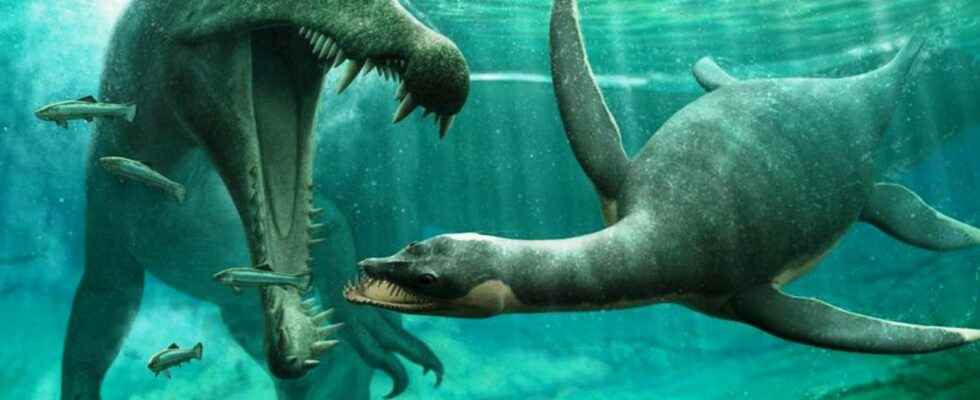You will also be interested
[EN VIDÉO] Interview: Five misconceptions about dinosaurs Cinema and literature maintain a certain mythology around dinosaurs. These claims, often totally erroneous, have the gift of offending experts and informed followers. Futura-Sciences therefore went to meet Éric Buffetaut, paleontologist, in order to sift through five received ideas about dinosaurs.
Do you know “Nessie”? No doubt yes, although he has become much less famous in the 21st century.e century than in the XXe. It is of course the famous monster of the Loch Ness, in Scotland ! It is often represented in the form of a plesiosaur, one of the emblematic animals of the time of the dinosaurs with the pterosaurswhich evolved in theair. The plesiosaurs (also called plesiosaurians) ruled the waters, but in both cases these creatures were not dinosaurs. Moreover, concerning the plesiosaurs, it was not even a question of reptiles classics, as the etymology of “plesiosaur” indicates: the term is constructed from the Greek plesios“close to”, and sauros, ” lizard “. Let us recall in passing that since the appearance of the classification phylogenetica growing number of biologists and paleontologists consider that the concept of “reptile” should no longer be used in the scientific classification of speciesalthough the term is still in common use outside of it.
This may be what plesiosaurs looked like when they were alive. © Julian Johnson-mortimer
Nessie has still not been discovered and certainly could not be a plesiosaur for at least two reasons. In a photo supposed to show Nessie, her neck appears bent vertically like that of a swan, but this is a mechanical impossibility for a plesiosaur. Finally, the skeletons of plesiosaurs discovered for the first time in 1823 by the huntress of fossils British Mary Anning are always associated with sediment sailors, thus showing that these animals were not adapted to thepure waterlike that of an environment lake and therefore a lake.
Morocco, a paradise for geologists and paleontologists
This objection has just been lifted following the discovery of fossils of small plesiosaurs in the strata deposited by a 100 million year old river system, strata that are today in the desert from the Sahara to Morocco, more precisely in the Kem Kem region. It is a vast semi-desert tabular rocky plateau made up of an immense slab crowned with limestone Cenomano-Turonian massif (Cretaceous upper) wedged to the northwest by the Anti-Atlas paleozoic.
These fossils were found by an international team of researchers from the University of Bath and the University of Portsmouth in the UK, as well as Hassan II University in Morocco.
As explained in a publication in the journal Cretaceous Research, fossilized remains of plesiosaurs include adult bones and teeth three meters long and a baby’s arm bone 1.5 meters long. They suggest that at least one species of plesiosaurs could live perfectly well in thepure wateralongside frogs, crocodilesof turtlesof Pisces and a mythical genus of dinosaurs theropods aquatic animals belonging to the extinct family of Spinosauridae : Spinosaurus. We find in fact fossils of these animals in Morocco in strata also dating from the Cretaceous.
Another animation, but with spinosaurs. © Julian Johnson-mortimer
“ The bones and teeth were found scattered and in different localities, not in skeletal form. So each bone and each tooth is a different animal. We have over a dozen animals in this collection “, explains Nick Longrich in a press release from the University of Bath, one of the paleontologists author of the published article. His blog gives many details on this discovery.
The study of the teeth shows that they present a strong wear, like that of the spinosaurs found in the same strata, which implies that the plesiosaurs ate the same food and especially that they spent a lot of time in the rivers, rather than d to be occasional visitors.
It therefore seems that plesiosaurs were able to tolerate fresh and salt water, like certain whales, like the belugaor that they were completely adapted to fresh water, as is the case with certain dolphins in the Ganges, the Yangtze River or even in the Amazon.
Interested in what you just read?
